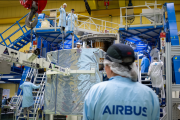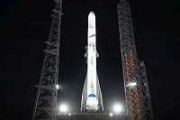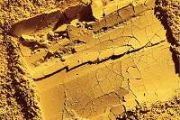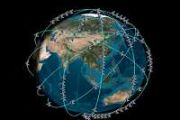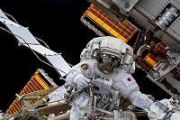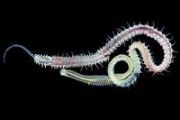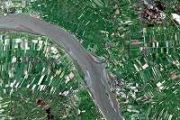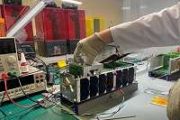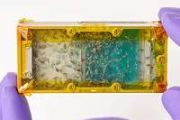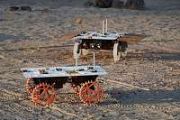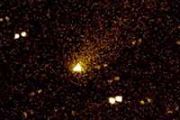
Copernical Team
Astronomers detect rare neutral atomic-carbon absorbers with a deep neural network
 Recently, an international team led by Prof. GE Jian from the Shanghai Astronomical Observatory of the Chinese Academy of Sciences used deep learning neural networks to search for rare weak signals in quasar spectral data from the Sloan Digital Sky Survey III (SDSS-III) program. This study, published in the Monthly Notices of the Royal Astronomical Society, presents a new method for exploring ga
Recently, an international team led by Prof. GE Jian from the Shanghai Astronomical Observatory of the Chinese Academy of Sciences used deep learning neural networks to search for rare weak signals in quasar spectral data from the Sloan Digital Sky Survey III (SDSS-III) program. This study, published in the Monthly Notices of the Royal Astronomical Society, presents a new method for exploring ga Solar Storm's Impact Detected in Deep Sea Observatories
 The solar storm that recently drove the aurora borealis was also affecting compasses deep in the ocean, according to new findings by Ocean Networks Canada (ONC), a University of Victoria initiative.
ONC's subsea observatories on Canada's coasts recorded temporary distortions in the Earth's magnetic field on instrument platforms deployed as deep as 2.7 kilometers. These are some of the most
The solar storm that recently drove the aurora borealis was also affecting compasses deep in the ocean, according to new findings by Ocean Networks Canada (ONC), a University of Victoria initiative.
ONC's subsea observatories on Canada's coasts recorded temporary distortions in the Earth's magnetic field on instrument platforms deployed as deep as 2.7 kilometers. These are some of the most Researchers Discover New Insights into Carbene Formation
 A team led by University of Maryland chemists has found a new method to create carbenes, highly reactive molecules essential for many chemical reactions, including those that produce carbohydrates. Carbenes are important precursors to the building blocks of life on Earth and potentially in space.
The researchers created hydroxymethylene (HCOH), a carbene, by breaking down methanol (CH3OH)
A team led by University of Maryland chemists has found a new method to create carbenes, highly reactive molecules essential for many chemical reactions, including those that produce carbohydrates. Carbenes are important precursors to the building blocks of life on Earth and potentially in space.
The researchers created hydroxymethylene (HCOH), a carbene, by breaking down methanol (CH3OH) Orbex partners with MSP for automated component production
 Orbex has announced a partnership with MSP to enhance the automation of component production for its orbital launch services from the UK.
MSP will supply technology to automate the production of components for Orbex's orbital launch services, aiding in the company's preparations for its first launch.
Based in North East England, MSP aims to optimize CNC machine productivity by automa
Orbex has announced a partnership with MSP to enhance the automation of component production for its orbital launch services from the UK.
MSP will supply technology to automate the production of components for Orbex's orbital launch services, aiding in the company's preparations for its first launch.
Based in North East England, MSP aims to optimize CNC machine productivity by automa Office of Space Commerce Extends TraCSS Project
 The Office of Space Commerce (OSC) has announced a one-month extension of the Consolidated Pathfinder project supporting the Traffic Coordination System for Space (TraCSS).
Launched in January 2024, the Consolidated Pathfinder is a short-term project focusing on space situational awareness (SSA) for the low Earth orbit (LEO) regime. The project examines how commercial SSA capabilities can
The Office of Space Commerce (OSC) has announced a one-month extension of the Consolidated Pathfinder project supporting the Traffic Coordination System for Space (TraCSS).
Launched in January 2024, the Consolidated Pathfinder is a short-term project focusing on space situational awareness (SSA) for the low Earth orbit (LEO) regime. The project examines how commercial SSA capabilities can Ariane 6 will launch 3D Printing technology into space
 Europe's newest rocket, Ariane 6, is set to launch, carrying multiple space missions. One notable mission is Replicator, a project by Orbital Matter, which will demonstrate new 3D printing technology in space.
The Replicator mission, a collaboration between Warsaw, Poland, and Berlin, Germany-based startup Orbital Matter, aims to show how 3D printing can be used in orbit, potentially enabl
Europe's newest rocket, Ariane 6, is set to launch, carrying multiple space missions. One notable mission is Replicator, a project by Orbital Matter, which will demonstrate new 3D printing technology in space.
The Replicator mission, a collaboration between Warsaw, Poland, and Berlin, Germany-based startup Orbital Matter, aims to show how 3D printing can be used in orbit, potentially enabl Hera tests CubeSat communication for asteroid mission
 The Juventas CubeSat, equipped with radar, is partially deployed from its Hera mission mothership inside ESA's Maxwell chamber for electromagnetic compatibility testing.
The foam pyramids around Hera absorb radio signals, while the Maxwell chamber's 9-m high metal walls block external radio interference. This space mimics the void of space, allowing the Hera team to validate the spacecraft
The Juventas CubeSat, equipped with radar, is partially deployed from its Hera mission mothership inside ESA's Maxwell chamber for electromagnetic compatibility testing.
The foam pyramids around Hera absorb radio signals, while the Maxwell chamber's 9-m high metal walls block external radio interference. This space mimics the void of space, allowing the Hera team to validate the spacecraft Glitch hampers bepicolombo mission to mercury
 BepiColombo, the joint ESA/JAXA mission to Mercury, has experienced an issue that is preventing the spacecraft's thrusters from operating at full power.
BepiColombo consists of two scientific probes and the Mercury Transfer Module, designed to separate during the mission's Mercury orbit insertion.
The solar arrays and electric propulsion system on the Mercury Transfer Module generate
BepiColombo, the joint ESA/JAXA mission to Mercury, has experienced an issue that is preventing the spacecraft's thrusters from operating at full power.
BepiColombo consists of two scientific probes and the Mercury Transfer Module, designed to separate during the mission's Mercury orbit insertion.
The solar arrays and electric propulsion system on the Mercury Transfer Module generate NASA and ESA Collaborate on ExoMars Rosalind Franklin Rover
 NASA and ESA announced they signed an agreement to expand NASA's work on the ExoMars Rosalind Franklin rover, an ESA-led mission launching in 2028 to search for signs of ancient life on Mars.
With this memorandum of understanding, NASA's Launch Services Program will secure a U.S. commercial launch provider for the Rosalind Franklin rover. NASA will also supply heater units and elements of
NASA and ESA announced they signed an agreement to expand NASA's work on the ExoMars Rosalind Franklin rover, an ESA-led mission launching in 2028 to search for signs of ancient life on Mars.
With this memorandum of understanding, NASA's Launch Services Program will secure a U.S. commercial launch provider for the Rosalind Franklin rover. NASA will also supply heater units and elements of Lithuania becomes 40th nation to join NASA's Artemis Accords
 Lithuania has become the 40th nation to sign NASA's Artemis Accords, a pact that defines the peaceful exploration of space.
Aušrinė Armonaitė, Lithuania's minister of economy and innovation, signed the accords Wednesday at the Radisson Blu Lietuva hotel in the capital Vilnius, with U.S. Ambassador Kara McDonald in attendance.
"Welcome to the Artemis Accords family, Lithuania,"
Lithuania has become the 40th nation to sign NASA's Artemis Accords, a pact that defines the peaceful exploration of space.
Aušrinė Armonaitė, Lithuania's minister of economy and innovation, signed the accords Wednesday at the Radisson Blu Lietuva hotel in the capital Vilnius, with U.S. Ambassador Kara McDonald in attendance.
"Welcome to the Artemis Accords family, Lithuania," 






